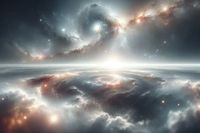James Webb Space Telescope Discovers Vast Star Factory Near Milky Way's Black Hole
A groundbreaking discovery by the James Webb Space Telescope reveals a massive star-forming region near the Milky Way's center, showcasing the birth of stars in stunning detail.

Revealing the Hidden Cosmos: Sagittarius C Unveiled
The James Webb Space Telescope (JWST) has captured a mesmerizing view of a star-forming region known as 'Sagittarius C', located just 300 light-years from the Milky Way's central supermassive black hole. This area is brimming with an estimated 500,000 stars, each emerging from dense clouds of molecular hydrogen and interstellar dust. The JWST's Near Infrared Camera (NIRCam) has played a crucial role in revealing this spectacular scene, showcasing a dense cluster of baby stars, including a rapidly growing star already 30 times the mass of our sun.
The process of star formation in this region is intriguing. Stars are born within cold, dense clumps of molecular hydrogen that succumb to gravitational collapse. These areas are interlaced with dust that maintains temperatures near absolute zero. However, even the JWST's advanced infrared capabilities sometimes cannot penetrate the thickest dust clouds, leaving some mysteries about the star formation process still veiled.
A New Perspective on the Milky Way's Core
A recent panoramic image from JWST's NIRCam has unveiled a 50 light-years-wide swath of the Milky Way's dense center, featuring the Sagittarius C region. This image not only displays about half a million stars but also reveals previously unidentified aspects of the region. Samuel Crowe, a University of Virginia student leading the analysis, emphasized the novelty of these features, brought into focus by the JWST's superior resolution and sensitivity. The image highlights the fascinating dynamics of this area, including protostar outflows and foreground stars juxtaposed against a backdrop of dark molecular hydrogen clouds.
This discovery is significant as the Galactic Center, located about 26,000 light-years from Earth, is a hotspot for intense star formation. Similarities have been drawn between this region and early star-forming galaxies from the universe's nascent era. These early galaxies, brighter than expected, may offer clues into the formation of massive stars, a process still shrouded in mystery.
Challenging Existing Theories of Star Formation
The observations of the Galactic Center by the JWST are particularly valuable for astronomers. They provide a unique opportunity to test current theories of star formation under extreme conditions. Jonathan Tan, a supervisor at the University of Virginia, highlights the Galactic Center's role in challenging our understanding of star birth. One key area of investigation is the stellar initial mass function (IMF), which describes the distribution of star masses at birth. The intense star formation activity in this region might defy the typical patterns observed in other parts of the Milky Way, potentially leading to a higher proportion of massive stars.
Rubén Fedriani, a member of the study team, describes the Galactic Center as a 'crowded, tumultuous place,' characterized by turbulent, magnetized gas clouds forming stars. The JWST has provided extensive data on this dynamic environment, offering insights into the complex interactions between newly formed stars and their surroundings. This research not only deepens our understanding of the Milky Way but also sheds light on the conditions in early galaxies of the universe.



